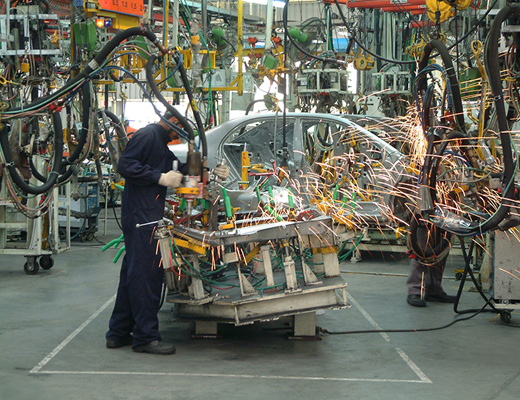* During FY24, India’s merchandise exports reached US$ 437.06 billion, down from US$ 451.07 billion in the previous fiscal.
* By 2030, Indian middle class is expected to have the second-largest share in global consumption at 17%.
![]()
* Propelled by growth in priority sectors and driven by favourable megatrends, India’s manufacturing sector has opened itself into new geographies and segments.
* Building on the competitive advantage of a skilled workforce and lower cost of labour, the manufacturing sector is also witnessing an increased inflow of capex and heightened M&A activity, leading to a surge in manufacturing output and resultant increased contribution to exports.
![]()
* India's manufacturing sector is poised to reach US$ 1 trillion by 2025-26, led by Gujarat, Maharashtra, and Tamil Nadu, fueled by investments in automobile, electronics, and textile industries. Government initiatives like Make in India and PLI schemes drive growth, attracting FDI and enhancing industrial infrastructure.
* DPIIT is boosting India's startup ecosystem and manufacturing sector by developing incubators to foster innovation, enhance competitiveness, create jobs, and strengthen the country's self-reliance and global trade position, with support from government initiatives and collaborations between corporates and startups.
![]()
* The positive developments in the manufacturing sector, driven by production capacity expansion, government policy support, heightened M&A activity, and PE/VC-led investment, are creating a robust pipeline for the country’s sustained economic growth in the years to come.
![]()
Manufacturing is emerging as an integral pillar in the country’s economic growth, thanks to the performance of key sectors like automotive, engineering, chemicals, pharmaceuticals, and consumer durables. The Indian manufacturing industry generated 16-17% of India’s GDP pre-pandemic and is projected to be one of the fastest growing sectors.
The machine tool industry was literally the nuts and bolts of the manufacturing industry in India. Today, technology has stimulated innovation with digital transformation a key aspect in gaining an edge in this highly competitive market.
Technology has today encouraged creativity, with digital transformation being a critical element in gaining an advantage in this increasingly competitive industry. The Indian manufacturing sector is steadily moving toward more automated and process-driven manufacturing, which is projected to improve efficiency and enhance productivity.
India has the capacity to export goods worth US$ 1 trillion by 2030 and is on the road to becoming a major global manufacturing hub.

With 17% of the nation’s GDP and over 27.3 million workers, the manufacturing sector plays a significant role in the Indian economy. Through the implementation of different programmes and policies, the Indian government hopes to have 25% of the economy’s output come from manufacturing by 2025.
India now has the physical and digital infrastructure to raise the share of the manufacturing sector in the economy and make a realistic bid to be an important player in global supply chains.
A globally competitive manufacturing sector is India's greatest potential to drive economic growth and job creation this decade. Due to factors like power growth, long-term employment prospects, and skill routes for millions of people, India has a significant potential to engage in international markets. Several factors contribute to their potential. First off, these value chains are well positioned to benefit from India's advantages in terms of raw materials, industrial expertise, and entrepreneurship.
Second, they can take advantage of four market opportunities: expanding exports, localising imports, internal demand, and contract manufacturing. With digital transformation being a crucial component in achieving an advantage in this fiercely competitive industry, technology has today sparked creativity. Manufacturing sector in India is gradually shifting to a more automated and process driven manufacturing which is expected to increase the efficiency and boost production of the manufacturing industry.
India is gradually progressing on the road to Industry 4.0 through the Government of India’s initiatives like the National Manufacturing Policy which aims to increase the share of manufacturing in GDP to 25 percent by 2025 and the PLI scheme for manufacturing which was launched in 2022 to develop the core manufacturing sector at par with global manufacturing standards.
India is planning to offer incentives of up to Rs. 18,000 crore (US$ 2.2 billion) to spur local manufacturing in six new sectors including chemicals, shipping containers, and inputs for vaccines.
India's mobile phone manufacturing industry anticipates creating 150,000 to 250,000 direct and indirect jobs within the next 12-16 months, driven by government incentives, and increased global demand. Major players like Apple and its contract manufacturers, along with Dixon Technologies, are expanding their workforce to meet growing production needs.
Manufacturing exports have registered their highest ever annual exports of US$ 447.46 billion with 6.03% growth during FY23 surpassing the previous year (FY22) record exports of US$ 422 billion. By 2030, Indian middle class is expected to have the second-largest share in global consumption at 17%.
India’s gross value added (GVA) at current prices was estimated at US$ 770.08 billion as per the quarterly estimates of the first quarter of FY24.
India's e-commerce exports are projected to grow from US$ 1 billion to US$ 400 billion annually by 2030, aiding in achieving US$ 2 trillion in total exports.
India's GDP surged by 8.4% in the October-December quarter, surpassing expectations. GDP growth was driven by robust performances in the manufacturing and construction sectors, with the manufacturing sector expanding by 11.6% annually and the construction sector growing by 9.5%.
The manufacturing sector of India has the potential to reach US$ 1 trillion by 2025-26.
India has potential to become a global manufacturing hub and by 2030, it can add more than US$ 500 billion annually to the global economy.

As per the economic survey reports, estimated employment in manufacturing sector in India was 5.7 crore in 2017-18, 6.12 crore in 2018-19 which was further increased to 6.24 crore in 2019-20. India's display panel market is estimated to grow from ~US$ 7 billion in 2021 to US$ 15 billion in 2025.
The manufacturing GVA at current prices was estimated at US$ 110.48 billion in the first quarter of FY24.
Some of the major investments and developments in this sector in the recent past are:
The Government of India has taken several initiatives to promote a healthy environment for the growth of manufacturing sector in the country. Some of the notable initiatives and developments are:
India is an attractive hub for foreign investments in the manufacturing sector. Several mobile phone, luxury, and automobile brands, among others, have set up or are looking to establish their manufacturing bases in the country. The manufacturing sector of India has the potential to reach US$ 1 trillion by 2025. The implementation of the Goods and Services Tax (GST) will make India a common market with a GDP of US$ 3.4 trillion along with a population of 1.48 billion people, which will be a big draw for investors. The Indian Cellular and Electronics Association (ICEA) predicts that India has the potential to scale up its cumulative laptop and tablet manufacturing capacity to US$ 100 billion by 2025 through policy interventions.
One of the initiatives by the Government of India's Ministry for Heavy Industries & Public Enterprises is SAMARTH Udyog Bharat 4.0, or SAMARTH Advanced Manufacturing and Rapid Transformation Hubs. This is expected to increase competitiveness of the manufacturing sector in the capital goods market. With impetus on developing industrial corridors and smart cities, the Government aims to ensure holistic development of the nation.

The corridors would further assist in integrating, monitoring, and developing a conducive environment for the industrial development and will promote advance practices in manufacturing.
References: Central Statistics Office, FICCI, Economic Survey of India, DPIIT, Media sources, Ministry of Skill Development and Entrepreneurship, Economic Survey 2022-23, Union Budget 2023-24, Press Information Bureau, News Articles